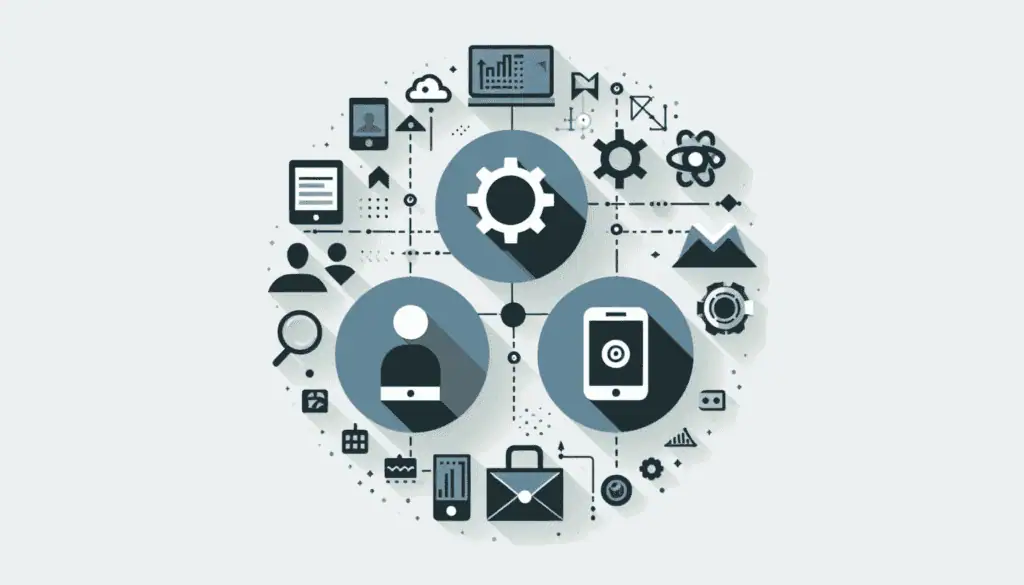Navigating the Intersection of People, Process, and Technology

Written By:
Last Updated Date:
TL;DR
Digital transformation has become essential in the corporate landscape. It involves leveraging technology to revolutionize organizational processes, enhance efficiency, and reduce costs. Beyond adopting emerging technologies, digital transformation fundamentally reshapes how companies operate and deliver value.
The People, Process, Technology (PPT) framework is crucial. Integrating these three elements addresses potential resistance to change and ensures seamless tech adoption. A well-defined digital strategy tailored to specific objectives guides technology selection and implementation. The pandemic accelerated digital transformation, emphasizing agility, remote work, e-commerce, and redefined customer experiences. Now, more than ever, businesses must embrace digital transformation to thrive in an ever-changing landscape.
Key Takeaways
- PPT Framework for Seamless Digital Transformation: The People, Process, Technology (PPT) framework is essential for successful digital transformation. It emphasizes integrating skills, optimizing processes, adopting the right technologies, addressing resistance, and ensuring smooth implementation.
- Impact of the Pandemic on Digital Transformation: COVID-19 accelerated digital transformation, highlighting the necessity of agility, remote work, e-commerce, and redefined customer experiences. Businesses must embrace digital strategies to remain competitive in an evolving landscape.
- Enhanced Models for Effective Change Management: Leveraging frameworks like ADKAR, Kotter’s 8-Step Model, and Prosci’s 3-Phase Process can complement the PPT model. These models provide structured approaches to managing change, ensuring leadership buy-in, and fostering a culture of continuous improvement and adaptability.
Imagine your company finally investing in a new technology, a shiny solution to a long-standing problem. Excitement spreads through the office, and visions of a smoother workflow are in everyone’s heads. The go-live date approaches and the excitement reaches new heights.
But then, dreams crashed like waves crashing on the stones of reality. People started to resist the change, and fears of being replaced by the new digital initiatives started spreading while others struggled to grasp its complexities. You start hearing the mutter, “This doesn’t fit our internal processes!” and returning to the old working methods. Slowly, the tide recedes. The new solution is left untouched, a ghost ship in a harbor of habit.
The go-live date arrives with a whimper, not a bang. The promised ROI is nowhere to be found. You’re left scratching your head, wondering what went wrong!
Sounds familiar?
It wasn’t just the technology that failed.
People and processes were left behind.
What is Digital Transformation?

Digital transformation is now an essential term for business operations. Digital technology has revolutionized organizational processes and their interaction with stakeholders to improve operational efficiency, quality, and cost reduction. Digital transformations aim primarily at creating new value for customers and stakeholders and helping to improve performance. As digital landscapes evolve, it becomes vital that organizations not only retain the competitive advantage but foster innovative ideas successfully.
The new digital age presents both challenges and opportunities for businesses. To thrive in this environment, many organizations are embracing digital transformation. This comprehensive approach goes beyond simply adopting emerging technologies. It’s about utilizing a digital transformation framework to reshape a company’s operations and fundamentally deliver value.
A robust digital transformation framework, such as the People, Process, Technology (PPT) model, provides a foundation for success. This framework emphasizes the importance of integrating all three elements. By focusing on people’s skills and fostering a culture of change, a digital transformation framework can address potential resistance and encourage the adoption of digital strategies. Additionally, the framework highlights the need for process optimization to ensure seamless integration with the chosen technologies.
Developing a winning digital transformation framework is crucial. This digital strategy should be tailored to the organization’s specific digital transformation objectives. Whether aiming to improve customer satisfaction, enhance operational efficiency, or gain a competitive edge, a well-defined digital transformation strategy serves as a roadmap, guiding the selection and implementation of appropriate technologies. Furthermore, the business strategy should outline clear communication plans to keep all stakeholders informed and engaged throughout the transformation journey.
By embracing a digital transformation framework and crafting a well-defined digital strategy, businesses can harness the power of technology to adapt, innovate, and unlock new levels of success in the digital economy.
How The Pandemic Accelerated Digital Transformation?

The concept of digital transformation wasn’t born in 2020, but the year of COVID-19 undoubtedly served as a powerful accelerant. Before the pandemic, digital transformation strategies were often seen as long-term initiatives, with implementation plans gathering dust on shelves. However, COVID-19’s sudden arrival forced businesses to confront a new reality demanding immediate adaptation and agility.
Social distancing measures and lockdowns made traditional, in-person operations nearly impossible. This urgency thrust digital transformation frameworks and strategies to the forefront. Here’s how COVID-19 made digital transformation a critical component:
Remote Work Necessity
Lockdowns necessitated a rapid shift to remote work models. Businesses scrambled to implement cloud-based collaboration tools, video conferencing platforms, and secure remote access solutions. This mass migration to digital tools highlighted the importance of a successful digital transformation strategy for ensuring business continuity and employee productivity in unforeseen circumstances.
E-commerce Boom
With physical stores shuttered, consumer behavior shifted dramatically towards online shopping. Businesses with established e-commerce platforms thrived, while those lagging were forced to play catch-up. This surge in online commerce underscored the need for a digital transformation strategy that prioritizes a seamless online shopping experience and robust digital marketing efforts.
Customer Experience Redefined
Social distancing guidelines made traditional customer interactions impossible. Businesses had to reimagine customer service and engagement through digital channels. This led to adopting chatbots, self-service portals, and enhanced social media engagement strategies. This period highlighted the importance of a digital transformation framework integrating customer experience across all digital touchpoints.
The pandemic served as a wake-up call, exposing the limitations of businesses overly reliant on traditional methods. The companies already invested in digital transformation frameworks and strategies were better equipped to weather the storm. COVID-19’s impact wasn’t limited to immediate crisis response. It fundamentally changed how businesses operate and how customers interact with them. A well-defined digital transformation strategy is no longer a luxury; it’s a critical survival tool in today’s ever-changing business landscape.
Why is the digital transformation framework essential?

McKinsey estimates that 70 percent of transformations fail. Often, the pitfalls include a lack of leadership and poor cross-functional cooperation. A framework can help eliminate risk by offering a practical path to success. The program aims to help employees in agile business conditions keep up with the changing business environment. Several consulting firms have developed digital transformation frameworks for their clients’ businesses. This typical pattern is seen in the majority of frameworks.
While digital transformation has always been a path to growth and efficiency, the events of 2020 and beyond have cemented its status as an absolute necessity for business survival. Here’s why:
Rapidly Evolving Landscape: Technology advancements happen ever-increasingly, and customer expectations shift constantly. Businesses that don’t continuously adapt through digital transformation risk falling behind competitors who leverage the latest tools and strategies.
The “New Normal” Demands Agility: The COVID-19 pandemic highlighted the need for businesses to be agile and adaptable. Unforeseen disruptions can occur anytime, and a digital transformation framework equips a company to respond swiftly and effectively.
Customer Centricity: Today’s customers expect seamless, digital experiences across all touchpoints. A robust digital transformation framework helps businesses optimize their online presence, personalize customer journeys, and strengthen their understanding of customer segments.
Unlocking New Revenue Streams: Digital transformation opens doors to innovative business models and revenue streams. From e-commerce platforms to subscription services, a well-defined digital transformation framework allows businesses to explore new products and services.
The Challenge of Transformation and the Power of Frameworks

Despite its undeniable importance, McKinsey estimates a staggering 70% failure rate for digital transformation initiatives. Why? Common pitfalls include:
Lack of Leadership Buy-In: Without a strong business leader’s commitment and a clear vision, digital transformation efforts can lose momentum and direction.
Siloed Operations: Transformation requires collaboration across all departments. Poor communication and departmental resistance can hinder progress.
Unrealistic Goals and Timelines: Trying to achieve too much, too fast, or setting unrealistic goals can lead to frustration and failure.
This is where a digital transformation framework comes in. It acts as a strategic framework, providing a structured approach to the transformation process. Frameworks typically emphasize:
Alignment on Goals: A clear understanding of the desired outcomes ensures all efforts are directed toward achieving digital transformation objectives.
People-Centric Approach: Digital transformation frameworks acknowledge the importance of employee buy-in and provide tools to address potential resistance and foster a culture of continuous learning.
Process Optimization: Existing processes are evaluated and streamlined to ensure seamless integration with digital strategies.
Technology Selection and Implementation: Digital transformation frameworks guide the selection of appropriate technologies and provide a structured approach to implementation.
Why do People Matter for Entrepreneurs?

Navigating the ever-evolving digital landscape is a constant challenge for entrepreneurs—the emergence of technologies, growing customer expectations, and market dynamics force organizations to implement changes.
That is when agility in adapting to change and the ability to guide your business units in adapting to digital transformation are critical to sustaining long-term success. This is where change management comes in.
At the heart of effective change management lies a powerful concept—the integration of People Process and Technology (PPT).

This article will cover the concepts and practical steps to leverage the people process and technology framework, also known as Leavitt’s Diamond Model, Venn diagram, or ‘Golden Triangle,’ developed in 1965. We will explore its impact and analyze the subsequent enhanced models to further strengthen your digital transformation approach and help you achieve your strategic direction.
A Step-by-Step Guide for Entrepreneurs to Implement PPT Model

Large corporations have dedicated business units for managing change, and for entrepreneurs managing small to medium-sized businesses, wearing many hats is usually the case. The people process and technology framework empowers you to take a holistic approach to your digital transformation initiative, even with limited resources. Here’s why it matters:
Limited Resources: The people process, and technology framework allows you to leverage your resources effectively, streamline business processes, and identify technology solutions to automate tasks and free up your and your team’s time.
Build a Strong Team: Involving your team in the change process gives them a sense of ownership, improves communication, facilitates digital adoption, and reduces resistance. This is crucial for the buy-in within your team for successful implementation.
Adaptability and Accelerate Growth: As your business evolves, the PPT model provides a framework for continuous improvement. By regularly evaluating processes and integrating new technologies, you can ensure your business remains agile and competitive.
Enhanced Models to Power Up Your Process Beyond PPT

Now, let’s talk about the practical steps to implement the people process and technology framework in your startup:
1. Define Your Change Goals
Clearly define your outcomes by understanding the “why” behind the change. Ask yourself, are you:
Launching new products and services?
Creating new operating models?
Pivoting to a new business model?
Changing to a remote work environment?
Optimizing customer service processes?
2. Assess Your People
Consider your team’s skills and comfort with change, and identify resistance areas. Then, communicate openly with your team, addressing those concerns early on.
3. Process Mapping
Document your operational processes and identify bottlenecks. Streamlining business processes enhances productivity and agility in adopting and integrating new solutions.
4. Research Technology Solutions
Research potential solutions that align with digital transformation goals and budgets. Those solutions include:
Security tools
Accounting and finance
AI and Automation tools
Marketing and sales tools
Project management tools
Productivity and collaboration tools
5. Engage Your Team
Discuss the “why” for change with your team, encourage them to share their ideas for improvement, and address their concerns. This reduces resistance and creates a sense of ownership.
6. Create a Communication Plan
Communicate change clearly to your team, and outline the timeline and the benefits of change. Communicate with your squad openly and update them regularly with challenges that emerge during the change process.
7. Training and Support
Providing your team with the necessary training and support helps them adapt to change and facilitates comfort in adopting new working methods. This involves training, workshops, and knowledge-sharing sessions.
8. Monitor and Stay Agile
Change needs patience. Monitor the progress, collect feedback from your team, and be prepared to adapt your approach as needed. Celebrate successes and acknowledge challenges openly.
Enhanced Frameworks for Entrepreneurs

While the people, process, and technology framework is a strong foundation, the model has had many enhancements over the years that offer good insights for entrepreneurs:
ADKAR Model
ADKAR model addresses the individual’s psychological needs to influence the successful adoption of new processes and technology. The model focuses on five key outcomes an individual needs to achieve for successful change:
(A) Awareness of the change and understanding its purpose to reduce resistance.
(D) Desire to see the value of improving their work, career prospects, and the organization.
(K) Knowledge and skills necessary to navigate change.
(A) Ability to use the knowledge and skills to boost confidence.
(R) Reinforcement by providing ongoing support to sustain the change and prevent returning to old habits.
Tips: Schedule one-on-ones with your team to assess their ADKAR levels and provide support.
Kotter’s 8-Step Model
This model was developed by Harvard professor John Kotter, providing a structured approach for successful change at the individual level:
Create a Sense of Urgency, selling the change to your team by highlighting the reasons for change, telling stories from data, revealing external threats, and focusing on drawbacks from the status quo.
Form a Powerful Guiding Coalition and assemble the influencing champions from different levels of the business to provide direction and overcome resistance.
Create a vision for change to inspire people for the vision post-change and develop a robust strategy for goals, plans, and milestones.
Communicate the vision clearly through various channels in a way that resonates with individuals and is easy to understand.
Remove obstacles to empower individuals to embrace the change by providing resources and training while encouraging risk-taking and creativity in finding solutions.
Celebrate small wins early to create short-term wins and show that change works, building momentum and boosting morale.
Reinforce the change, use momentum to embed change in the organization, and reward employees for desired behavior.
Anchor new change in corporate culture and integrate the desired behaviors, processes, and values into the culture. Promote and develop business leaders who embrace the change for long-term sustainability.
Tips: Use Kotter’s model as a checklist for strategic planning and implementing your change.
Prosci 3-Phase Process
Prosci 3-phase methodology builds on people process and technology framework by achieving change at the organizational level:
Phase 1 – Prepare Approach: Defining the change, assessing the impact, and developing a digital transformation framework.
Phase 2 – Manage Change: Implementing the business transformation strategy through communication, training, and reinforcement activities.
Phase 3 – Sustain Outcomes: Ensure the change is embedded in the organization’s culture and delivers sustainable growth.
Tips: Identify a champion in your leadership team who can sponsor the change and advocate for its success.
Remember: These enhanced models do not replace the PPT model. They are complementary tools. By understanding the core principles of the PPT and leveraging insights from these enhanced models, you can build a practical digital transformation framework for your organization.
Invest in the Right Technologies

Technology comes at the last stage of digital transformation but plays a crucial role in enabling change. Here are some key considerations for entrepreneurs:
User-Friendliness: Choose digital platforms that are intuitive and easy to learn.
Scalability: Choose scalable solutions like cloud services that offer flexible pricing models.
Security: Choose solutions with robust features and comply with data privacy regulations such as GDPR and CCPA.
Integration: Consider the new technology integration capabilities with your existing digital capabilities to minimize disruption and maximize efficiency.
Building a Culture of Digital Transformation

Success in digital transformation is not just about implementing a specific model or technology but changing the adaptable culture that fosters continuous improvement. Here are some tips for entrepreneurs:
Lead by Example: Show your commitment to change through your behaviors and actions and encourage your team to embrace the digital transformation journey.
Communicate Openly: Address concerns honestly and encourage open communication within your team.
Celebrate Progress: Celebrate small and big wins with your team to raise morale and keep them motivated.
Employ Feedback Loops: Continuously ask for the team’s feedback throughout the process, identify improvement areas, and adapt the process as needed.
Conclusion
The People Process and Technology framework (PPT) is a robust foundation for entrepreneurs to navigate change and achieve successful digital transformation. You gain greater control throughout the process by integrating the concepts and leveraging the power of enhanced models like Kotter, ADKAR, and Prosci. This enables you to implement digital transformation effectively, leverage technology, innovate new products and services, incorporate digital technologies into your organization’s culture, and sustain it for your long-term business success.
Adaptability, open communication, and involving everyone in the digital transformation journey will pay dividends to enable your organization to scale and thrive in today’s dynamic business world.
Frequently Asked Questions (FAQ)
I’m a technology specialist and entrepreneur with over 20 years of experience in the IT industry. I’m passionate about innovation, ideation, and commercialisation, and enjoys working with businesses helping to improve their processes and technological architecture. I have a Masters in Commercialisation and Innovation that brings a unique perspective to my expertise, having experience in various industries and countries.






